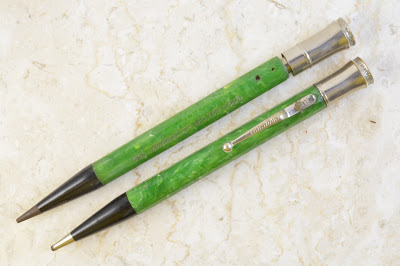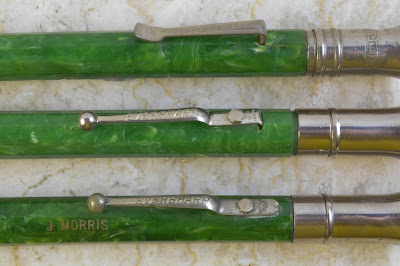This article has been edited and included in The Leadhead's Pencil Blog Volume 4; copies are available print on demand through Amazon here, and I offer an ebook version in pdf format at the Legendary Lead Company here.
If you don't want the book but you enjoy this article, please consider supporting the Blog project here.
Michael Little sent me images of this one some time ago and asked if I was interested:
This little hard rubber number has an interesting tip and a nice, thick lead. The tip didn’t appear to move and neither did the lead, so for the time being I decided not to force it.
What really had me attracted to this one was the imprint:
“John Blair - NY / Pat. Feb. 9th 1892.” The reference, unfortunately but kind of interestingly, has nothing to do with a pencil:
John Blair of Brooklyn, New York filed an application for a fountain pen on November 14, 1891, which was awarded as number 468,322 on February 9, 1892. Blair was issued 14 patents between 1885 and 1909, all of which are listed (shameless plug time) in
American Writing Instrument Patents 1799-1910. A fifteenth Blair patent, for a sleeve filler fountain pen, was awarded in 1911 and is included in
American Writing Instrument Patents Volume 2; 1911-1945.
And not one of these patents is for a mechanical pencil.
John Blair is one of those minor manufacturers who apparently enjoyed some success over a period of decades. In this advertisement, published in 1913, Blair claimed to have founded his business in 1881:
Although Blair’s patent history makes it appear that he became interested in stylographic pens later in his career, with patents on the subject issued in 1903, there was a “Blair Ink Pencil Company” in New York which was advertising for salesmen in 1883:
Interestingly, for all of you Conklin guys out there (myself included), Blair offered a sacless fountain pen which he called – the “Nosak”:
However, it was Blair’s stylographic pen business that interested me more; the point section of my pencil had to be adapted from the stylographic line rather than from a fountain pen feed, I thought. I did find an advertisement for Blair’s stylographic pens, with a picture, in the March, 1909 issue of
Popular Mechanics:
But note that the pen is shown with a cap, and the point section is shaped differently from mine.
And so, with all this research in hand, I still didn’t feel like I knew enough about this one to write something up, and the draft of this article quietly slipped into the dead letter office, awaiting more information to pin down John Blair’s mysterious pencil.
That information came in an online auction recently for an empty box sleeve:
This box shows my pencil EXACTLY, and it is loaded with information:
The Blair ink pencil pictured here was a cross between a stylographic pen, a felt tip marker and a trench pen: the directions indicate that there was an ink “cartridge” which would be inserted into the barrel, which was filled with water to activate the ink. To make the ink blacker, the directions suggest stabbing the tip of the cartridge with a hat pin. Since the directions indicate that the tip unscrews, and it appears to be identical to my pencil, I decided to force the issue a bit more, and after a few tense moments, the end did come off:
Revealing that in addition to using ordinary ink, the Blair Ink Pencil could also be fitted (with or without the manufacturer’s blessing) with a piece of lead, which is held in place perfectly by the tip. Further, the lead is actually marked:
It’s a piece of Johann Faber lead. Whether Blair ever marketed his ink pencil also as a regular lead pencil hasn’t been established, and this may well have been the work of an improvising pen owner who didn’t have a Blair ink cartridge handy at the moment his or her ink pencil ran dry.
There’s one other valuable piece of information on this box worthy of our attention: Blair’s address at 163 Broadway. The 1883 advertisement provides an address of 163 Chambers, while the ones from 1909 and later indicate the firm was located at 6 John Street. The 163 Broadway address falls in between, as indicated by this advertisement from September, 1905:
In Trow’s Business Directory of 1899, Blair was listed with an address of 52 Nassau:
But by the time this interview Blair provided to Printer’s Ink was published on December 5, 1900, he was located at the Broadway address:

























































